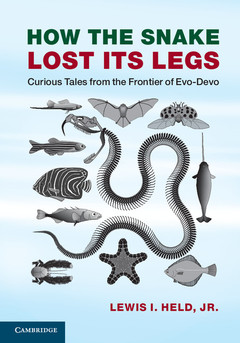Description
How the Snake Lost its Legs
Curious Tales from the Frontier of Evo-Devo
Author: Held, Jr Lewis I.
This book explores the latest developments in evo-devo to explain the science behind tiger stripes, camel humps, and other fascinating animal traits.
Language: English
Subject for How the Snake Lost its Legs:
Approximative price 40.18 €
In Print (Delivery period: 14 days).
Add to cart
How the Snake Lost its Legs
Publication date: 01-2014
306 p. · 17.5x24.6 cm · Paperback
Publication date: 01-2014
306 p. · 17.5x24.6 cm · Paperback
Approximative price 98.15 €
In Print (Delivery period: 14 days).
Add to cart
How the Snake Lost its Legs
Publication date: 01-2014
306 p. · 17.9x25.3 cm · Hardback
Publication date: 01-2014
306 p. · 17.9x25.3 cm · Hardback
Description
/li>Contents
/li>Biography
/li>
How did the zebra really get its stripes, and the giraffe its long neck? What is the science behind camel humps, leopard spots, and other animal oddities? Such questions have fascinated us for centuries, but the expanding field of evo-devo (evolutionary developmental biology) is now providing, for the first time, a wealth of insights and answers. Taking inspiration from Kipling's 'Just So Stories', this book weaves emerging insights from evo-devo into a narrative that provides startling explanations for the origin and evolution of traits across the animal kingdom. Held's unique and engaging style makes this narrative both enlightening and entertaining, guiding students and researchers through even complex concepts and encouraging a fuller understanding of the latest developments in the field. The first five chapters cover the first bilaterally symmetric animals, flies, butterflies, snakes, and cheetahs. A final chapter surveys recent results about a menagerie of other animals.
Preface; 1. The first two-sided animal; 2. The fly; 3. The butterfly; 4. The snake; 5. The cheetah; 6. An evo-devo bestiary; Epilogue; Glossary; References; Index.
Lewis I. Held, Jr is Associate Professor of Biology at Texas Tech University, Lubbock, Texas, USA. He has taught developmental biology and human embryology to pre-medical students for 27 years, and received the 2010 Professing Excellence Award and the 1995 President's Excellence in Teaching Medal (Texas Tech University). He is also the author of Quirks of Human Anatomy (Cambridge, 2009), Imaginal Discs (Cambridge, 2002) and Models for Embryonic Periodicity (1992).
© 2024 LAVOISIER S.A.S.




